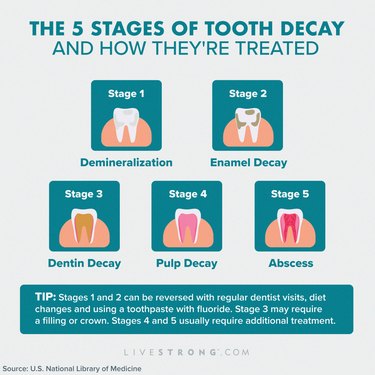

The Refresh is helping you freshen up on your oral-care knowledge and upgrade your dental-hygiene routine.
Maybe you forgot to reschedule that last dental visit you canceled twice. Or you're too tired at the end of the day to floss your teeth. It happens! But a habit of neglecting your oral health can lead to tooth decay, or damage to your tooth's surface (aka enamel), according to the U.S. National Library of Medicine (NLM).
And, when this tooth decay remains untreated, it can cause cavities — that is, holes in your teeth — along with major dental problems, per the NLM.
Video of the Day
Video of the Day
The good news is that if you do develop tooth decay, early attention and treatment can keep problems from getting worse and even reverse damage that has already begun. Here's what you need to know to treat tooth decay, and then keep it at bay.
What Exactly Causes Tooth Decay?
The culprit behind tooth decay is bacteria.
Specifically it's the bacteria found within plaque that lead to decay, per the America Dental Association (ADA). Plaque is a sticky film that sits on top of your teeth, and it uses the sugars in your food and drinks to make acids that attack and eat away at tooth enamel, according to the NLM.
It takes time for the decay to work its way through the protective layer of enamel — up to three years, per the Cleveland Clinic. From there, the bacteria and acids can make their way deeper into the tooth.
When you brush your teeth, you remove this plaque, which helps prevent tooth decay from beginning or progressing.
Eating a lot of sugar and not brushing and flossing your teeth or seeing a dentist regularly are related causes of tooth decay, according to Marisol Tellez, BDS, PhD, associate professor and graduate program director of Dental Public Health at Temple University's Maurice H. Kornberg School of Dentistry. Family history and not having enough saliva, which has protective properties against tooth decay, may contribute to tooth decay, Tellez says. Medications and acid reflux also cause tooth decay.
Cavities are also more common for children, teens and older people, per the Mayo Clinic.
Tooth Decay Symptoms
You may not have any signs of tooth decay early on. But as tooth decay progresses, you may develop symptoms that include the following according to the NLM:
- White, and later dark, spots on your teeth
- Tooth pain or sensitivity to heat and cold
- Loose or chipped fillings
- Bad breath that doesn't go away with brushing or mouthwash
- A visible hole in your tooth
- An infection
A dentist can confirm you have tooth decay with a checkup, by asking questions about your symptoms and by taking an X-ray.
How to Treat Tooth Decay

How you get rid of tooth decay depends on how far it has advanced. Tooth decay progresses through five stages, says Erinne Kennedy, DMD, MPH, dentist and American Dental Association spokesperson. These are:
- Demineralization, which is when the acids in your mouth cause the enamel on your teeth to lose minerals.
- Tooth decay in the enamel, which may cause white spots on your teeth to turn brown.
- Tooth decay in the dentin, the layer under the tooth enamel, which may cause your teeth to become sensitive.
- Damage to the pulp, the layer under the dentin containing nerves and blood vessels, which can cause tooth pain.
- Abscess, or infection, which can cause pain and swelling.
Here's how tooth decay is treated, depending on how far it's progressed.
Reversing Early Tooth Decay
Luckily you can reverse tooth decay in the early stages (1 and 2). To do so, Tellez says, you'll need to:
- Brush your teeth twice a day with fluoride toothpaste for two minutes. Fluoride — aka nature's cavity fighter — is a naturally occurring substance that strengthens tooth enamel and reverses early tooth decay, according the ADA. It also prevents further decay by replacing lost minerals, per the NLM. It's found in tap water and dental products.
- Shift your diet to cut back on sugary and starchy food and drinks.
- See a dentist regularly — this may add up to two to four times a year, depending on your risk for developing tooth decay, Tellez says.
Filling Cavities
If you have developed a cavity and your decay is moderate or advanced, a dentist will have to restore lost tooth structure by removing the decay and filling the hole in your tooth, Tellez says.
Although you can stop the decay from progressing, you won't be able to reverse the damage from decay once tooth structure has been lost.
Root Canal or Extraction
If the decay or an infection spread to the pulp, you may need a root canal, filling and crown, according to the American Association of Endodontists (AAE). Here's what happen during a root canal, per the AAE: your dentist will clean the inside of the tooth, then fill and seal it. A crown will be placed on top of the repaired tooth.
If the damage with the tooth can't be repaired, the dentist may have to pull the tooth — it will then be replaced with a bridge or implant to prevent a gap in your mouth, which could cause your other teeth to shift around, per the NLM.
The amount of time it takes for tooth decay to progress varies because so many things affect dental health, Tellez says. "A whole cavity may take years to develop. One thing we do know is that progression of tooth decay in babies is very, very fast because their enamel is thinner — so we have to act very quickly."
What Happens if You Don’t Treat Tooth Decay?
Not treating tooth decay can affect your overall quality of life, causing pain, infection and tooth loss, Tellez says. As problems with your teeth get worse, chewing, digestion and your overall nutrition may be compromised, she adds.
If you get a infection due to tooth decay, it can cause difficulty breathing and spread to other parts of the body. “If you have an infection in the teeth in your upper jaw, it can go into your sinuses and cause discomfort or a chronic infection,” Dr. Kennedy says.
How to Prevent Tooth Decay
You can prevent tooth decay by taking proper care of your teeth, gums and overall health. Follow these steps, per the ADA:
- Brush your teeth twice a day with toothpaste that has fluoride and clean between your teeth once a day using floss or a between-the-teeth tool.
- Eat healthy foods as part of a balanced diet and limit food and drinks that are bad for your teeth — that's anything that sticks to them, along with sweet and acidic items. Plus, avoid snacking.
- Drink water with fluoride and talk with your dentist about fluoride treatments and sealing — or putting a protective coating on — the surfaces of your back teeth, where bacteria tend to collect.
- Visit your dentist for regular checkups and cleanings. Let your dentist know about any dental or health conditions that may increase your chances of developing tooth decay. For instance, if you have dry mouth, that lack of saliva could increase your risk of tooth decay, per the National Institute of Dental and Craniofacial Research.
When to See a Dentist
You should see a dentist as soon as possible if you have a toothache or any mouth pain, according to the Mayo Clinic. However, sometimes you may not have symptoms or realize you're getting a cavity. That's why it's important to go to the dentist for routine checkups and cleanings, even when your mouth feels fine, per the Mayo Clinic.
- Mayo Clinic: "Cavities/tooth decay"
- U.S. National Library of Medicine: "Tooth Decay"
- American Dental Association: "Fluoride"
- American Association of Endodontists: "What is a Root Canal?"
- ADA: "Decay"
- National Institute of Dental and Carniofacial Research: "Dry Mouth"
- ADA: "Cavities"
- Cleveland Clinic: "Cavities"
Is this an emergency? If you are experiencing serious medical symptoms, please see the National Library of Medicine’s list of signs you need emergency medical attention or call 911.


